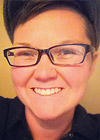It was my first time to the NAFSA annual conference, also my first year in the field, and I traveled to San Diego alone.
Attending NAFSA can be overwhelming in the way family reunions show how far your family name extends and how few people you know. Not knowing anyone, it is tempting to stand at the edge of the room, walking in only for hors d’oeuvres (which I did at one of the receptions).
My first time at NAFSA, I was determined to get involved. For this to happen, I needed a plan, a master list. Many boxes would need to be checked. A few weeks after the conference program arrived, I decided to start the process. This would require an Americano and a few hours of reading through session descriptions, poster topics, volunteer options, and more. Similar to planning a trip, I needed to think strategically to make the most of my time.
This moment of strategy arrived when I saw that the Career Center would be offering a case-study challenge. This was the fulcrum by which to focus my week. I now had a conference conversation starter—"have you heard of the case study challenge?"
Most people had not. They didn’t know about this opportunity for young professionals to work in a team and present a solution to challenges in the field of international education But that didn’t impact the amount of information they wanted to share.
The convention center was my library, and there were experts walking all around me. Taking the shuttle to my hotel, I spoke with a NAFSA regular. Waiting to buy a coffee, I shared ideas with a cultural competency trainer. I spoke with DSOs at poster sessions. At a meeting spot, I made conversation with an associate director.
Participating on the challenge allowed me to network with individuals I may not have otherwise spoken to. And rather than taking notes and saving them for when I returned to the office, I was taking notes, discussing ideas, and finding ways to incorporate them into my presentation.
Unexpectedly, the conference became one larger clustering exercise where I only needed to draw out the connections—each person I spoke with, each poster I walked by, each session I attended. Making connections was both the challenge and the most beneficial part.
When Friday morning came, my partner, Lisa Maroni, and I were able to present the connections we had made—with offices on the fictional NAFSA campus, resources available to NAFSA administrators, and most importantly, the connections between our fields—education abroad and international recruitment and admissions.
My first year at NAFSA, I had a scheduled presentation. And this time, I was not the audience. I was the expert—able to share successes from the work I am doing at the University of Utah and strategies of how international offices can work together to best use their resources.
Though I came to San Diego alone, by participating in this challenge, I returned to Salt Lake City with a presentation to be proud of, a better understanding of how my work relates to other fields, and confidence that I have a voice in the field of international education.
Make your own connections next year in Boston and compete in the case-study challenge!
 Ashley Glenn is a Learning Abroad Coordinator at the University of Utah and a recent returnee to the United States of America. After completing her MA in History, she moved to Wuhan, China to teach business writing and academic writing courses, and now combines this experience in China and time spent in student affairs when advising students and creating programming for returned students. At the University of Utah, Ashley works with both domestic and international students through coordinating the university’s exchange program and serving as a staff partner for the Go Global Living Learning Community.
Ashley Glenn is a Learning Abroad Coordinator at the University of Utah and a recent returnee to the United States of America. After completing her MA in History, she moved to Wuhan, China to teach business writing and academic writing courses, and now combines this experience in China and time spent in student affairs when advising students and creating programming for returned students. At the University of Utah, Ashley works with both domestic and international students through coordinating the university’s exchange program and serving as a staff partner for the Go Global Living Learning Community.
